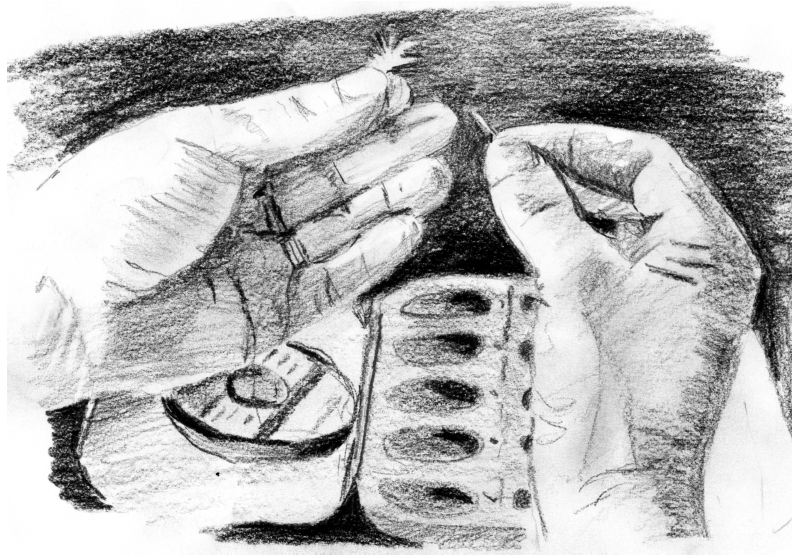

AS NO MAN IS BORN AN ARTIST, NO MAN IS BORN AN ANGLER.
—Izaak Walton
Setting up the tenkara rod is easy. After extending the rod, you will only need one or two knots: the first to occasionally tie on a new tippet, and the second to tie on your fly. The simplest approach is to add tippet with a loop-to-loop junction and to tie on the fly with whatever knot your father taught you.
In the following pages you’ll find several different knots that do the same thing. It is an understatement to say anglers have their knot preferences and prejudices. But there is no test ever devised that proves the worthiness of a knot so much as a wildly jumping rainbow trout. As you fish, you will discover your personal preferences. My advice is to pick a few knots and practice them so that you can tie them consistently and with cold hands in fading light.
The furled line is attached to the rod tip with a simple larkshead or girth hitch. Tie an overhand knot in the small line attached to the tenkara rod tip, the lilian. This serves as a simple stop to the hitch. Now bend the loop of the furled line back on itself, as illustrated. Guide the lilian through the hitch and pull the hitch tight.
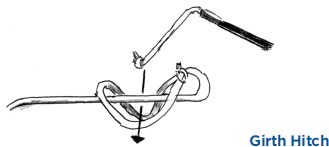
There are several ways to attach level lines. My preference is to tie a simple overhand knot around the standing part of the line to form a loop. I feed the lilian through the loop twice and tighten. To loosen the knot at the end of the day, I simply pull on the tag end with my hemostats; if you put a stopper knot (figure eight or overhand) on the tag, you can simply loosen it by hand. How easy is that?
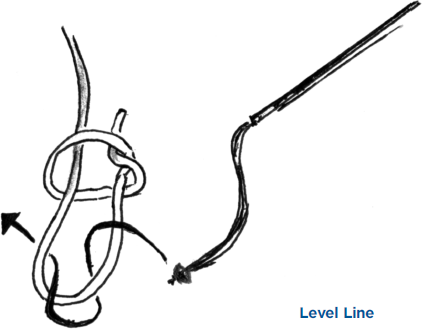
Another way to rig level lines is to simply convert it with a loop made from line backing. Then you can attach the line with the girth hitch just like you do with the furled line. Attach a loop of Dacron backing (made with a simple overhand loop with the backing doubled) to the mono. (A perfection loop in the mono works.) Leave a quarter inch tag on the backing to make unrigging easy. This is even faster when changing lines frequently.
Tippet is the final section to which the fly is attached. Since the furled line comes with a loop, adding the tippet to the line with a loop is very easy. Pass a loop of tippet over the loop of the furled line, then feed the tail of the tippet through the same loop. This is called a loop-to-loop connection.
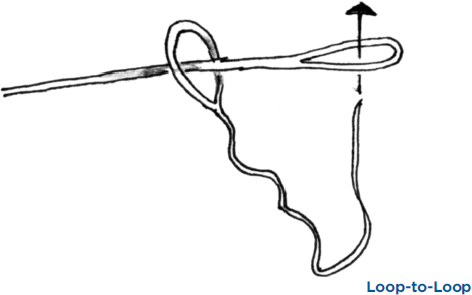
There are a number of ways to tie the loop in the end of your tippet. A simple double surgeon’s loop will work. The loop is formed with a doubled-up tippet and a two-turn overhand knot.
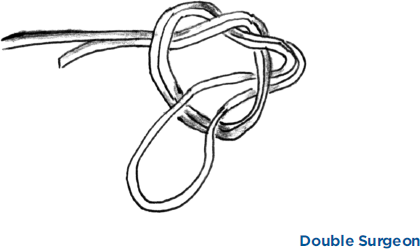
A double figure-eight loop is another easy method that takes little time to tie. It is simply a figure-eight knot tied with a doubled-up tippet to make a loop.

My preference though is a perfection loop since it is “in-line,” and with a little practice can be tied quickly. Make a loop by crossing behind the standing line, so the tag is pointing right. Now go around again, making a second loop in front and pinching the tag behind the first loop. You can use your middle finger to pinch it against the back of the index finger or just add it to the index and thumb pinch. Now take the remaining tag around front and split the two loops, laying it down in the pinch of your finger and thumb. Simply reach through the first loop and grab the second loop (capturing the tag in between the two loops) and pull tightly.
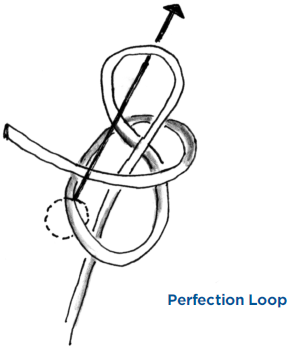
Loop-to-loop connections are just fine, but there is a new gadget, called a tippet ring, that can make tying lines even easier, and also protect them from wear. Some furled lines come with a tippet ring attached already. Just tie to the ring exactly like you would tie to a hook. I like a uni knot for this task. If your furled line does not have a tippet ring, one can be added easily with a small length of monofilament.

An alternative way of attaching tippet to a level line is to tie a stopper knot in the line and tighten a loop on it as illustrated. Tenkara master Dr. Hisao Ishigaki uses this method to tie on his tippet.
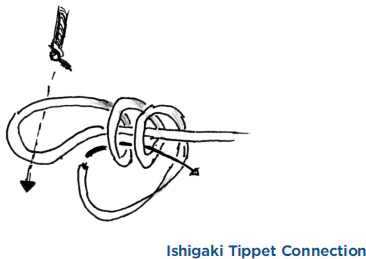
Lastly, the traditional double surgeon’s knot can be used to attach tippet. It is simply an overhand knot doubled. The only drawback to this simple approach is that you lose a bit of your level line every time you tie on tippet.
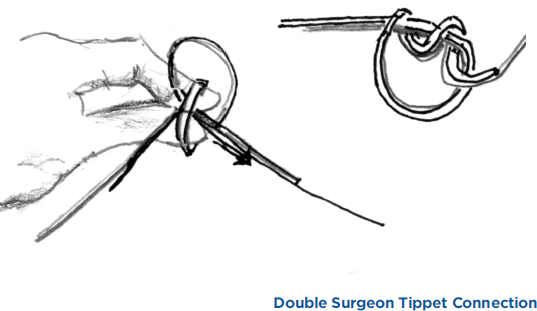
A quick way to tie this is to pinch the two pieces of fluorocarbon, then wrap your finger and thumb twice. Pass the ends back over the windings and then through.
To attach your fly to the tippet, many anglers prefer a Davy knot, which is simply an overhand knot with the tag tucked. This knot, popularized by fly fisher Davy Wotten, requires a trick however, if it is to have any strength at all. This knot must be started with the tippet passing from beneath in a down-turned eyehook and tightened by tugging the standing end, not the tag. Another trick is to hold the tag in your teeth next to the fly when tightening, wetting it while pulling the standing end. This serves to moisten the knot and prevent friction as you tighten the knot. If the tag in your teeth is small enough, it usually doesn’t even need to be trimmed. Super fast, this knot is the best knot to preserve tippet and the fastest fly changer of all time, and thus popular with many competition anglers.
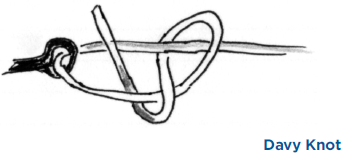
Other knots like the clinch, Harvey, and Orvis can be used to tie on flies and are perfectly fine. The Harvey, for instance, guarantees that the fly comes off the tippet in a straight line. Ishimura uses the uni knot. I use the Davy except for bigger flies, then I use the Eugene Bend.
To tie a Eugene Bend with a hemostat, after threading the fly, form a simple loop in the tag. While pinching the loop over the standing line, reach through the loop with the hemostat tip to one side of the standing line and wind the loop around the standing line three times. Now grab the tag and pull it through and tighten. Popularized by Bruce Harang, this quick knot is easy even when tying with cold hands. When the knot is correctly cinched to the eye, you will feel a reassuring “click.”
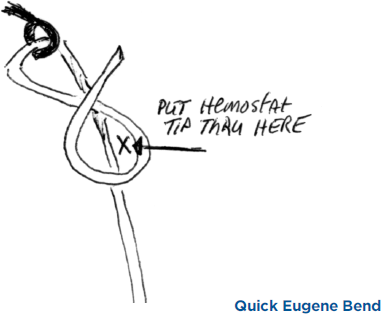
For extra credit, you can “snell” the dry fly using this knot, too. Instead of tying that uni with the fly above the loop as above, let the fly drop down the standing part of the tippet. Now tie the same knot, but before tightening on the now empty loop, take the whole fly and pass it partway through the formed loop, tightening the knot on the shaft of the fly behind the eye.
In most circumstances, fishing with more than one fly increases your odds. Tie on a dropper and double your chances.
The standard way is to simply tie a length of tippet to the hook bend with a uni or clinch knot. This is fine if you are fishing a hopper-dropper or dry-dropper combination. But with the hook of the first fly bound and under tension, it lowers the effectiveness of the upper fly.
For two or more subsurface flies you have a couple choices. One is to simply tie a perfection loop in a piece of tippet and saddle-loop it over the standing line above the existing tippet knot. I can put this on and take it off at will. This is a good way to add a leg for bead or shot weight too. Keep it short though or you’ll start tangling.
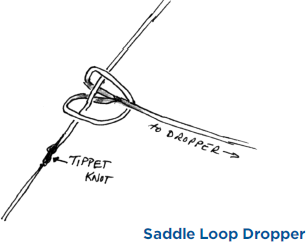
An alternative is to just make a big tippet loop (it should be half the distance you would like between the dropper fly and the anchor fly). Take the tag of the loop back to the point where you want the first dropper. Tie in a triple surgeon’s knot right there, and cut one leg of the formed loop a little longer than you want the dropper to be. Then just tie on the flies to the two legs formed when you cut the loop. The short leg is your dropper and the long your anchor or point fly.
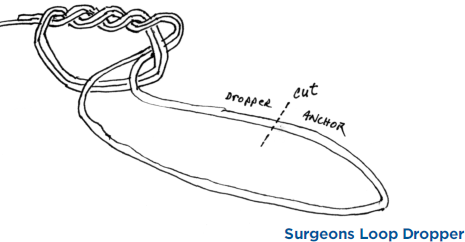
Of course you can just leave your tag long when you tie your tippet on the tippet ring and use that as a leg too. But I often add a dropper after I’ve given a single fly a workout, since casting with a single fly is more accurate and, I think, more fun.
These knots are more than you’ll ever need to fish tenkara. Don’t be intimidated. Spending thirty minutes at home with some spare monofilament is all it takes to commit them to memory. When you first start fishing, on-stream knots and changing flies can be a little frustrating, especially when you want to hurry up and fish. Here are a few things that help.
You might like clip-on (to glasses or hat) magnifiers, which help old eyes enormously. I am practically helpless without them. When you thread a fly or form a knot, do so against an uncluttered background (pants leg for instance). Threaders are the most reliable way to get the tippet through the eye of the hook. Some nippers have a threader built in and one even has a magnifier, though I don’t prefer them to a separate threader. Sewing needle threaders do work for thin tippet and are the most compact solution. The anvil-shaped magnetic threaders work fairly well too, but there is a trick: Place the fly so the bend is facing up the gutter. After feeding the cleanly cut tippet, pinch it against the threader. Then you can lift the fly to test for successful threading without dropping it. Remember, wet your knot before tightening and always test your knot with a firm tug before risking that next cast on an untested knot.
Though rigging a tenkara rod is very simple, take time to mindfully prepare for the stream. The first cast or two sometimes sets a pattern for the day, so slow down and be aware of where that long rod tip is wiggling. After you are rigged up, take at least a moment or two to watch the water for signs of fish, then plan your approach. Because many of the streams I fish are tight with brush, my first cast of the day will often be a bow and arrow cast. (You’ll see why in the chapter on casting.) By easing into the stream you increase your chances of a more productive and relaxing day of fishing. And after all, isn’t that why you came?